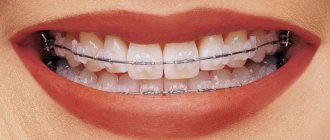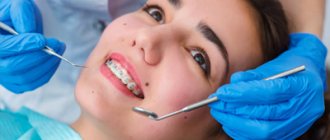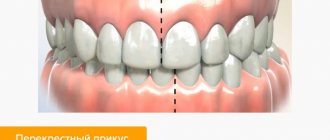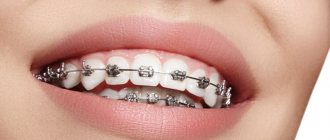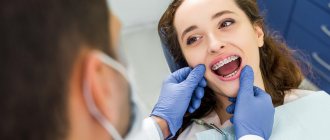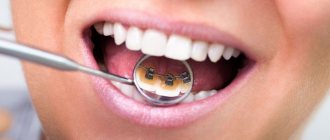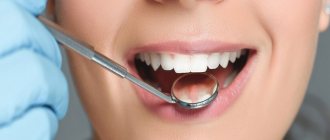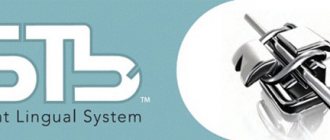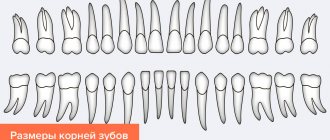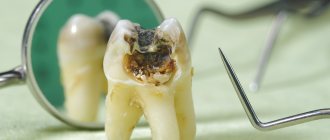Orthodontic treatment is a rather long and complex process. But the possibilities of modern orthodontics are very extensive. Of course, it is not possible to move a tooth from the lower jaw to the upper one, but moving a premolar or “pulling out” teeth hidden in the jaw and occupying an incorrect position is quite possible. You can correct malocclusion and straighten your teeth using different methods and technologies. The most effective are aligners and braces. Each of these methods has its own advantages and disadvantages. The doctor can say which method will be optimal in a particular clinical case after a comprehensive diagnosis.
What are braces
Braces are non-removable orthodontic structures consisting of locks, an arch connecting these locks into a single system and additional elements (ligatures, chains, elastics, springs, etc.). The clasps are fixed to the enamel with special glue and are not removed during the entire correction period. The operating principle of such systems is based on the ability of the arc to return to its original position. Straightening up, she presses on the locks, gradually moving the teeth to the desired position. The result obtained is stabilized with retainers and mouthguards at the final stage of treatment.
The teeth straightening system can be ligature or self-ligating, vestibular or lingual. Braces systems are made from different materials - metal, ceramics, artificial sapphire. The most durable are metal systems, while ceramic and sapphire models have the best aesthetic qualities.
Let's sum it up
Thus, the patient is unlikely to be able to find the answer to the question of what is more effective – braces or aligners – on his own. The best option will be the one that is suitable for solving a specific problem. This requires a detailed consultation with an orthodontist, who, based on the results of the examination, photographs and the condition of the teeth, can recommend braces or mouth guards.
The patient’s task is to carefully follow the recommendations for caring for the oral cavity and orthodontic structure and regularly visit the clinic throughout the entire treatment period.
In what cases is the installation of braces indicated?
- Profile correction – elimination of aesthetic problems associated with the position of teeth in a row;
- malocclusion;
- anomaly of individual teeth or the entire dentition;
- preparation for implantation or prosthetics;
- crowded teeth;
- disproportionate development of the jaws;
- removal of unerupted teeth.
Treatment with ligature systems takes an average of 2.5-3 years; self-ligating devices are usually worn for 1-2.5 years. The duration of the correction course depends on the model of the brace system and the complexity of the clinical situation.
Veneers are an alternative, but not an analogue of braces
What else can be used instead of braces? For example, veneers are thin plates of composite or ceramic, which are made from personal impressions for each patient and applied to the cutting edge and the front surface of the tooth. Unlike braces, veneers do not change your bite by moving your teeth. They only mask uneven teeth, chips, and large interdental spaces, essentially performing an aesthetic function. In addition, veneers protect teeth from damage. The installation of veneers can be recommended for adult patients who do not want to correct their bite with braces, but dream of a beautiful smile and straight teeth. It is important to consider that when installing veneers, the dentist must grind down the tooth, and this process is irreversible.
What are aligners
Aligners are a removable orthodontic aligner made of transparent thermoplastic polymer. The design exerts weak gradual pressure on the teeth, ensuring their displacement along a given trajectory. To achieve the desired result, a set of corrective aligners of different shapes and sizes are made, which are changed sequentially (every 2 weeks). You need to wear the system 22-23 hours a day, every day, removing it only for food and hygienic care.
Differences between braces and aligners
It’s quicker to answer what these correction systems have in common. They perform the same tasks: normalize occlusion and straighten teeth. Each teeth straightening system is different in design, mechanism of action, and area of application. If the brace system puts pressure on the teeth using locks and a tension arc, the impulse to move the tooth during treatment with aligners is created by special activators.
Each mouthguard has an individual trajectory of mechanical impact on the dentition. One aligner moves the teeth by approximately 0.2-0.3 mm, so the number of correctors in the set directly correlates with the clinical picture - the more complex the situation, the more aligners will be required for correction.
What's more aesthetically pleasing?
Aesthetics in orthodontics is the main criterion. All braces, except for lingual models, are visible to others up close. Even subtle systems made of ceramic and sapphire. The aligners are made from a transparent, elastic biopolymer, fit exactly to the teeth and are completely invisible. Visually, the appearance of a person does not change in any way.
The ease of use of corrective aligners is a definite plus. Care is not difficult in any way, there are no dietary restrictions or difficulties with hygiene - the aligners are removed when eating and brushing your teeth.
Advantages and disadvantages
| Pros of braces | Pros of aligners |
| Effective for bite defects of any degree of complexity | High aesthetics |
| Low price for metal models | Ultra-precise modeling technologies make it possible to create corrective systems taking into account the individual biomechanics of tooth and root movement |
| Suitable for long-term correction, which is required for complex, combined anomalies | Does not affect diction |
| No dietary restrictions | |
| No obstacles to quality oral hygiene | |
| Quick correction of minor malocclusions |
The disadvantages of orthodontic aligners include the high cost of treatment, a narrower range of indications than braces, and ineffectiveness if the patient lacks self-discipline. To achieve the desired result, aligners must be worn at least 20-22 hours a day.
Which method of correcting malocclusion pathologies is preferable?
Considering all the features, advantages and serious differences of corrective systems, the choice of patients predictably falls on mouthguards. But the final decision is made by the orthodontist, based on the clinical case, the nature and complexity of dental anomalies, the individual characteristics of the patient and other factors.
Before starting treatment, the patient undergoes an X-ray examination to accurately identify all pathologies. For a better understanding and choice of the optimal correction technique, it is worth undergoing a 3D scan and planning the future result.
To learn more about orthodontic treatment and find the best solution, call and schedule a consultation!
Advantages of aligners over braces
- Accuracy and efficiency
- the speed of treatment with aligners is 30% higher than with braces; - Safety
– the risk of damaging tooth enamel or injuring the mucous membrane when wearing corrective aligners is completely absent, which cannot be excluded when treated with a brace system; - Biocompatibility
– hypoallergenic polymer material, the absence of metal components allows the use of aligners for patients with allergies to metals and acrylic; - Predictability
– the patient sees the result even before the correction and production of aligners begins and can voice his wishes; - Aesthetics
– elastic aligners for teeth straightening do not damage the enamel, provide high-quality hygiene and are not visible when worn; - Efficiency
- appointments with the doctor are less frequent, no additional manipulations are needed as in the case of braces.
Types of orthodontic systems
There are various devices, plates, shields, guide crowns, and not just braces or aligners. All of them are designed for specific tasks and are prescribed only by a doctor. But in case of combined malocclusion, it is the latter that are most often used. Let's study what each system is, in what situations it helps, how it differs and how much it costs? What is better to use: teeth straightening aligners or braces?
Briefly about braces systems
The bracket system includes a power arch and special locks attached to the teeth. Orthodontic arches come in different sections and have different resistances. Straightening and moving inside the grooves of the locks, the arc smoothly guides the teeth into the correct position. During the treatment process, it is necessary to constantly visit the orthodontist for corrections - adjusting the position of the arch, changing ligatures, if they are used.
Braces can be lingual, attached to the inside of the teeth, or vestibular, external. Lingual ones are less noticeable, but their cost is higher, and fixation and therapy are more complicated. For each individual form of malocclusion, specific devices are indicated, so it is often practically impossible to focus on cosmetic preferences.
There are metal, plastic, sapphire, ceramic braces - they differ in the material of the locks themselves, so they can be of different strength and aesthetics. To fasten the arch in the grooves of the braces, ligatures are used - rubber or metal fasteners. The rubber bands can be used in any color, but they will still be visible on the teeth. There are also non-ligating (self-ligating) braces. They differ in that the arc holds in place by itself, gradually moving on its own. When wearing such a brace system, you need to visit the dentist much less frequently – up to once every 3 months.
Indications
With the help of braces, you can treat any malocclusion pathology: incorrect position of individual or groups of teeth, change the shape, size of the jaw, move or rotate the tooth as you like. You can also correct your bite with braces at any age, even if you have crowns in your mouth.
Contraindications
Correction is contraindicated in case of poor hygiene, untreated teeth, gum disease, oncology, some mental, infectious, endocrine, and immune diseases. Braces should also not be used by pregnant women, people with bruxism, or people with dental implants.
What are aligners
These are transparent and thin aligners that fit over the teeth of the entire jaw. The difference between aligners and mouthguards (protective, sports) is that they are made of hypoallergenic polymer, therefore thinner and tougher.
To make an aligner, computer modeling is required. The patient’s bite is gradually improved by removing the “negative” and creating a mouthguard based on its shape. By replacing one aligner with another, the patient approaches the most ideal bite - the position of the teeth, the shape of the dental arch, and the nature of the closure of the jaws are corrected.
Features of care
Hygienic care of the aligners does not require much effort. It is enough to wash the structure with water 2 times a day, clean it with a brush and treat it with an antiseptic solution. When eating or drinking coloring drinks, the mouth guard is removed and placed in a box. The patient wears one pair of aligners for 2-3 weeks, so the system does not have time to become heavily contaminated.
Hygiene with braces installed is more complex and requires a systematic, careful approach. Additional tools will be required for cleaning:
- Orthodontic, mono-beam brush;
- brush for cleaning hard-to-reach places, the space under the arch;
- irrigator.
You should brush your teeth and rinse your mouth every time after eating. Too hard, viscous and sticky foods should be excluded from the diet.
Adaptation period
Getting used to the orthodontic appliance takes about 2 weeks. Patients adapt to aligners more easily and quickly than to braces. This is due to the fact that mouthguards for straightening teeth can be removed independently, the elastic material does not injure the soft tissue, and due to the precise fit of the structure, sound pronunciation is not disturbed.
It is more difficult to get used to braces due to their design features. In addition, the first days of treatment are accompanied by pain. But in any case, adaptation to the corrective apparatus does not take more than 10-14 days.
Is it possible not to correct the bite?
There are patients who do not want to correct their bite either with braces or alternative options, believing that “slightly uneven teeth” are normal.
Dentists say the opposite. A bad bite is not only a matter of aesthetics, but primarily of health. Here are just some of the problems that can result from improperly aligned teeth:
- rapid abrasion of teeth and exposure of roots due to incorrect chewing load;
- frequent headaches due to dysfunction of the joint connecting the temporal bone and the lower jaw;
- diction disorders;
- difficult hygiene, which leads to the development of caries and other dental diseases;
- pathologies of the digestive tract arising from poor chewing of food;
- disorders in the musculoskeletal, respiratory and other systems of the body.
Thus, the bite is directly related to health, so it is necessary to straighten the teeth, but it is important to choose the correct correction method together with the dentist.
Which is more effective?
In terms of effectiveness, modern aligners and braces are almost identical, but there are situations when installing aligners is less advisable. This is especially true for complex, combined malocclusions, when corpus movement of the teeth is necessary. In this case, the best option is to install a bracket system. Aligners can cope with almost all anomalies, but severe malocclusion will require a very long time to correct. If you need to correct a crossbite or straighten a segment of teeth, it is more effective to use aligners than braces. The orthodontist will select the optimal correction method after a comprehensive diagnosis and comprehensive assessment of the clinical situation.
At what age can aligners be used, features of their installation
The advantage of aligners is that malocclusion treatment with their help can begin as soon as the child is able to cooperate with the orthodontist. It is to cooperate, that is, to follow the recommendations of the attending physician consciously and without whims.
- Their installation is acceptable at 6-7 years of age. At this age, the tissues are plastic, the bite is corrected quickly.
- For children with baby teeth up to 12-13 years of age, only aligners and plates are suitable; an adult or teenager can choose mouth guards or braces and compare them.
Before making mouth guards, parents and their child come for a consultation, where impressions are taken or teeth are scanned, on the basis of which a 3D model is created and a step-by-step plan for correcting the bite is developed. Material – hypoallergenic polymer. If you do not examine the dentition very closely at close range, it is impossible to notice the structure. The benefits of treatment with mouthguards include the psychological comfort of the baby. 70-80% of childhood malocclusion pathologies can be corrected with aligners. Special children's models have been developed, with features ranging from taking impressions to design “little details”.
Sometimes teenagers get aligners instead of braces; the decision is made taking into account all the factors in a particular case. On average, the cost of braces systems is lower than a set of aligners. But braces systems can be made not only from medical alloys or ceramics, but also from artificial sapphires and precious metals. Aligners are ideal for treating children of preschool and primary school age.
Of course, this is where aligners are better than braces, since they:
- Safe, absolutely smooth and fit snugly to the teeth.
- Does not damage enamel.
- Easy to take off and put on.
You can brush your teeth as usual. The period of adaptation is shortened - speech defects in the first days of wearing are not so obvious. In adults, special retention aligners can be installed after braces to consolidate the achieved result.
Make an appointment or bring your child, and together we will select an effective bite correction method for your case. In my experience there are already more than 10,000 cases of successful correction of dental anomalies in adults and more than 6,000 in children and adolescents.
